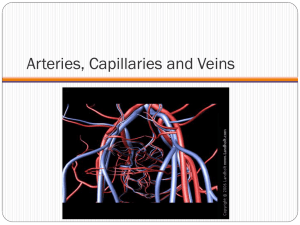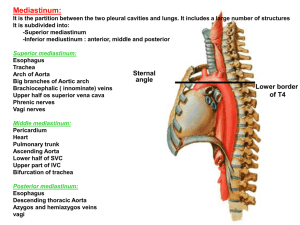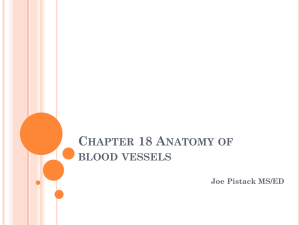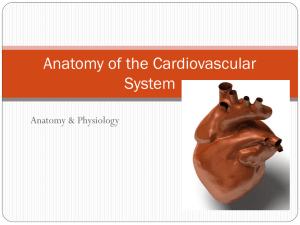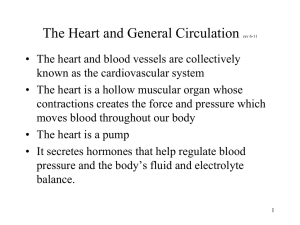VERTEBRATE CIRCULATORY SYSTEM
advertisement
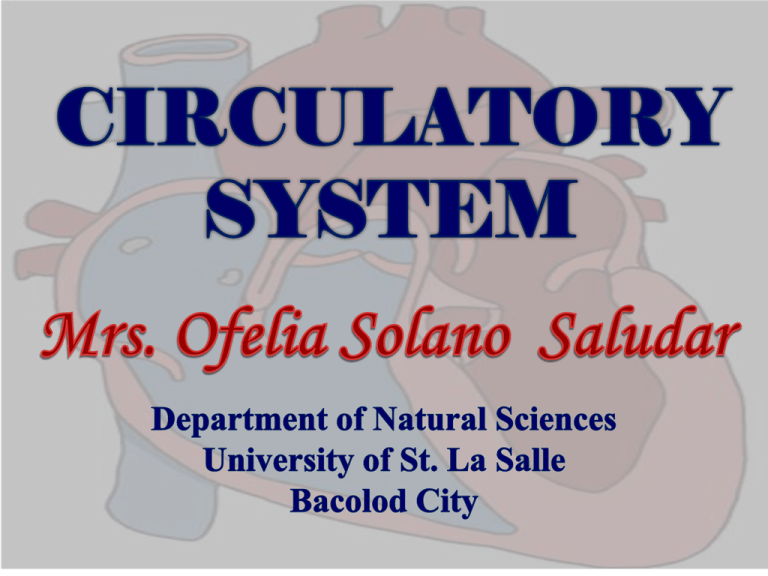
VERTEBRATE CIRCULATORY SYSTEM Transport gases, nutrients, waste products, hormones & various other materials; thermoregulation, immunity. Composed of: 1. BLOOD-VASCULAR SYSTEM- closed system consisting of blood vessels where the enclosed fluid travels in a circuit Arteries: carry blood away from the heart; have muscular, elastic walls; terminate in capillary beds Veins: carry blood back to the heart; have less muscle in their walls than arteries but the walls are very elastic; begin at the end of capillary beds Capillaries: have very thin walls (endothelium only); are the site of exchange between the blood and body cells Heart: a muscular pump (cardiac muscle) containing a pacemaker to regulate rate which can also be influenced by the Autonomic Nervous System 2. LYMPHATIC SYSTEM - open system consisting of vessels and sinuses which communicate with coelomic spaces of the body. Found in all vertebrates and composed of: Lymph and lymph vessels o Lymph is similar in composition to blood plasma. It bathes all cells & contains WBC, but RBC are absent. o Lymph empties into 1 or more veins (e.g., caudal, iliac, subclavian, & posterior cardinal. o Vessels are found in most soft tissues of the body & begin as blind-end lymph capillaries that collect interstitial fluid o Valves (present in birds & mammals) prevent backflow Lymph nodes - located along lymph vessels; contain lots of lymphocytes & macrophages Lymph hearts - consist of pulsating smooth muscle that propels lymph fluid through lymph vessels; found in fish, amphibians, & reptiles The entire circulatory system develops early from mesoderm mesenchyme. In the mesenchyme, central patches of cells give rise to blood cells, peripheral ones form blood vessels. Somatic vessels arise from somatic mesoderm; visceral vessels arise from splanchnic mesoderm. The 1st blood vessels are the vitelline veins. They are continued posteriorly as the subintestinal vein, and supply the yolk sac. The splanchnopleure fuse on the ventral side of the embryo, and the vitelline veins unite to form the heart. Dorsal & ventral mesocardia form but soon vanishes, leaving the heart free in the coelom, but attached only at its ends. Heart then lies in a median ventral part of the body enclosed by a portion of the ventral mesentery, the pericardial cavity. HEART Originally a straight tube, but since its 2 ends are fixed, it assumes an Sshaped curve as it grows. Subdivided into 4 chambers: sinus venosus, atrium, ventricle, conus arteriosus. The S-curvature brings the sinus near the ventricle, and the atrium near the conus. In tetrapods, the heart becomes more compact, bringing the ends of the great veins near the origins of the great arteries. Septa soon divide the atria and ventricles, making possible double circulation of blood. Sinus venosus becomes incorporated into wall of right atrium, while the conus splits into 2 trunks: systemic aorta and pulmonary trunk. CHONDRICHTHYANS Single-circuit, with 4 chambers: Sinus venosus- receives blood; filled by suction when the ventricle contracts and enlarges the pericardial cavity Atrium- a thin-walled muscular sac; an A-V valve regulates flow between atrium & ventricle Ventricle- muscular walls Conus arteriosus- leads into the ventral aorta; conal valves in the conus arteriosus prevent the backflow of blood TELEOSTS Heart is similar to that of cartilaginous fishes, except that a bulbus arteriosus (a muscular extension of the ventral aorta) is present rather than a conus arteriosus (a muscular extension of the ventricle) LUNGFISH & AMPHIBIANS Modifications are correlated with the presence of lungs & enable oxygenated blood returning from the lungs to be separated from deoxygenated blood returning from elsewhere. 2-circuit heart: partial or complete interatrial septum (complete in anurans and some urodeles) Partial interventricular septum (lungfish) or ventricular trabeculae (amphibians) to maintain separation of oxygenated & unoxygenated blood 5 = ventricle, 11 = right atrium, 12 = left atrium, 13 = conus arteriosus Formation of a spiral valve in the conus arteriosus of many dipnoans and amphibians. Spiral valve alternately blocks & unblocks the entrances to the left and right pulmonary arches (sending unoxygenated blood to the skin & lungs). Shortening of ventral aorta, which helps ensure that the oxygenated & unoxygenated blook kept separate in the heart moves directly into the appropriate vessels AMNIOTES Consists of 2 atria & 2 ventricles &, except in adult birds & mammals, a sinus venosus Complete interatrial septum (a foramen ovale is an embyronic hole in interatrial septum) Auricle is an expansion of atria in mammals only Complete interventricular septum only in crocodilians, birds, & mammals; partial septum in other amniotes In crocodilians, the ventricular septum is complete but a narrow channel, the Foramen of Panizza connects the base of the right & left systemic trunks Fate of Conus Arteriosus: 3 trunks in reptiles; 2 trunks in birds and mammals When a crocodilian is under water and not breathing, right ventricular pressure increases due to vasoconstriction of blood vessels supplying the lungs. As a result, the semilunar valve in the right aorta is forced open so blood from the right ventricle enters the right aorta rather than the pulmonary artery. Vital organs & tissues (skeletal muscles and the CNS) will get an increased blood supply additional oxygen. This allows crocodile to hunt by remaining underwater & 'ambush‘ prey. BIRDS AND MAMMALS No mixing of oxygenated & unoxygenated blood; complete interventricular septum + division of ventral aorta into 2 trunks: Pulmonary trunk takes blood to the lungs Aortic trunk takes blood to the rest of the body Result of modifications: All blood returning to right side of heart goes to the lungs; blood returning from lungs to the left side of heart goes to systemic circulation. AV valves- bicuspid & tricuspid in mammals Semilunar valvesbetween ventricles and trunks Sinus venosus- the pacemaker through reptiles; becomes the sinoatrial node in birds & mammals located in the wall of the RA Pacemaker- sets the pace for all heartbeats low pressure to body low pressure and low O2 to body high pressure & high O2 to body high pressure & high O2 to body Supply most tissues with oxygenated blood but carry deoxygenated blood to respiratory organs. Basic pattern: 1. ventral aorta emerges from heart & passes forward beneath the pharynx 2. dorsal aorta (paired above the pharynx) passes caudally above the digestive tract 3. six pairs of aortic arches connect the ventral aorta with the dorsal aortae FISHES Cartilaginous fishes: 1. Ventral aorta extends forward below pharynx & connects developing aortic arches. The 1st pair of arches develop first. 2. Segments of first pair are lost & remaining sections become efferent pseudobranchial arteries 3. Pairs 2-6 arches give rise to pre- & posttrematic arteries 4. Arches 2 - 6 become occluded; dorsal segments = efferent branchial arteries & ventral segments = afferent branchial arteries; capillary beds develop within nine demibranchs Teleosts: same changes except that the pulmonary artery branches off the 6th aortic arch to supply the swim bladder RESULT: Blood entering an aortic arch from ventral aorta must pass through gill capillaries before proceeding to dorsal aorta TETRAPODS - embryos have 6 pairs of aortic arches: • 1st & 2nd arches are temporary & not found in adults • 3rd aortic arches & the paired dorsal aortae anterior to arch 3 are called the internal carotid arteries; common carotid artery is from ventral aorta; external carotid artery is from common carotid artery • 4th aortic arches are called the systemic arches or the aorta • 5th aortic arch is usually lost • pulmonary arteries branch off the 6th arches & supply blood to the lungs AMPHIBIANS ANURANS- have 4 arches early in development (larval stage); arches III, IV, V & VI supply larval gills. At metamorphosis: • Aortic arch 5 is lost • Dorsal aorta between arches 3 & 4 is lost, so blood entering arch 3 (carotid arch) goes to the head • Ductus arteriosus of arch 6 is lost so blood entering this arch goes to the skin & lungs • Aortic arch 4 (systemic arch) on each side continue to the dorsal aorta & distributes blood to the rest of the body • Oxygenated blood from the left atrium & deoxygenated blood from the right are largely kept separate in the ventricle by: ventricular trabeculae and spiral valve in the conus arteriosus REPTILES - similar to amphibians except: • 2 aortic trunks from conus arteriosus send blood to arch 3 and 4 • One pulmonary trunk from conus arteriosus sends blood to 6th aortic arch • Ventral aorta - no spiral valve but truncus arteriosus is split into 3 Separate passages: 2 aortic trunks & a pulmonary trunk. As a result: 1. pulmonary trunk emerges from the right ventricle & connects with 6th aortic arches (deoxygenated blood from right atrium goes to lungs) 2. one aortic trunk comes out of left ventricle & carries oxygenated blood to the right 4th aortic arch & to carotid arches 3. the other aortic trunk appears to come out of right ventricle & leads to left 4th aortic arch. • Turtles, snakes, & lizards - the interventricular septum is incomplete where right & left systemic arches (4th) leave the ventricle & trabeculae in that region of the heart form a ‘pocket’ called the cavum venosum. • Oxygenated blood from the left ventricle is directed into cavum venosum, which leads to the 2 systemic arches. As a result, both the left & right systemic arches receive oxygenated blood BIRDS AND MAMMALS One aortic trunk sends blood to arches 3 and 4 One pulmonary trunk sends blood to arch 6 4TH Aortic Arch: Right side stays in birds, Left side stays in mammals Right side of 4TH arch becomes subclavian artery in mammals Ductus arteriosus is seen in fetus only; a bypass of blood from the pulmonary trunk to the aorta Carotids have same general pattern AORTIC ARCHES Dorsal aorta is the chief artery of the body caudad of the heart in all vertebrates, and has the same branches throughout. • The pulmonary veins appear as new structures in air breathing vertebrates. They enter the left auricle, initiating the changes leading to double circulation • Branches of dorsal aorta: 1. Somatic branches to skin, spine, muscles: Subclavian Brachial arteries supply arm Iliac A Femoral artery supplies leg 2. Lateral visceral branches: Urogenital 3. Ventral Visceral branches: Celiac artery- stomach, pancreas, liver Mesenteric artery- intestine (may be more than one) Veins start as capillaries & carry blood towards the heart In early vertebrate embryos, venous channels conform to a single basic pattern. As development proceeds, these channels are modified by deletion of some vessels & addition of others. The chief embryonic somatic veins are the: 1. Anterior & posterior cardinal veins, uniting at the level of the heart to a common cardinal vein (duct of Cuvier) 2. Subintestinal veins connects with one of the vitelline veins & makes a loop around the anus 3. Abdominal or umbilical vein opening into the common cardinal The vitelline veins break up in the liver. Their proximal ends remain as hepatic veins, distal portions form the hepatic portal which is continuous with the subintestinal, which now loses its connection with the caudal vein. The subcardinals appear between the kidneys, and join the posterior parts of the posterior cardinal veins as the renal portal. The caudal vein shifts to open into the posterior parts of the postcardinal veins, so that blood now flows from the postcardinals into the subcardinals. Lateral abdominal vein join the renal portals and unite anteriorly with the hepatic portal. Later they unite to form the ventral abdominal vein. The postcava arises from the hepatic veins, and fuse with the posterior cardinals and subcardinals. In adult reptiles, the anterior parts of the posterior cardinals disappear, leaving the postcava as the sole drainage for the subcardinals and the kidneys. The lateral abdominals become connected with the renal portal veins when the latter usurp the veins from the legs. Hence they constitute a connection between the renal portal and the hepatic portal systems. In birds, the postcava establishes direct connection with the renal portal veins so that the renal portal circulation thus become greatly reduced. In mammals the anterior part of the postcava is formed from the hepatic and right subcardinal; the rear part from the renal portal The supracardinal veins form the part between the subcardinals and the renal portal veins. The supracardinal 1st appears in reptiles, where they are the vertebral veins of the adult. Their anterior parts persist as the paired azygos vein of monotremes and marsupials; the right one as the single azygos vein of other mammals. Part of the left posterior cardinal persists as hemiazygos. With these connections, veins from the legs, tail and adjacent regions pass directly into the mammalian postcava. The renal portal system vanishes, and the abdominal vein loses its function; in embryos it persists as the allantoic or umbilical vein. It becomes the round ligament of the liver in the adult. The hepatic portal system remains unchanged throughout. The anterior cardinal veins persist in all vertebrates as the internal jugular vein, which after receiving other veins from the body form the PRECAVA Proximal portions of the precava are the common cardinal veins (duct of Cuvier). In some mammals the left precava joins the right precava in front of the heart, so that there is one precaval stem The reduced detached base of the left precava remains as the coronary sinus of the heart wall. Vitelline veins from yolk sac to heart Subintestinal vein from digestive visceral to vitelline vein MAMMALIAN FETAL CIRCULATION: In a developing fetus, blood obtains oxygen (& gives up carbon dioxide) via the placenta, not the lungs. Getting oxygenated blood from the placenta back to the heart & out to the body as quickly and efficiently as possible involves a series of vessels & openings found only in a mammalian fetus: a. blood (with oxygen & nutrients acquired in placenta) passes into umbilical vein b. blood largely bypasses the liver via the ductus venosus c. blood returns to the heart & enters right atrium, but much of the blood then bypasses the right ventricle & enters the left atrium via the foramen ovale d. blood that does enter the right ventricle largely bypasses the pulmonary circulation via the ductus arteriosus AT BIRTH: 1. Ductus arteriosus closes 2. Foramen ovale sealed off 3. Blood no longer flows through umbilical vein



